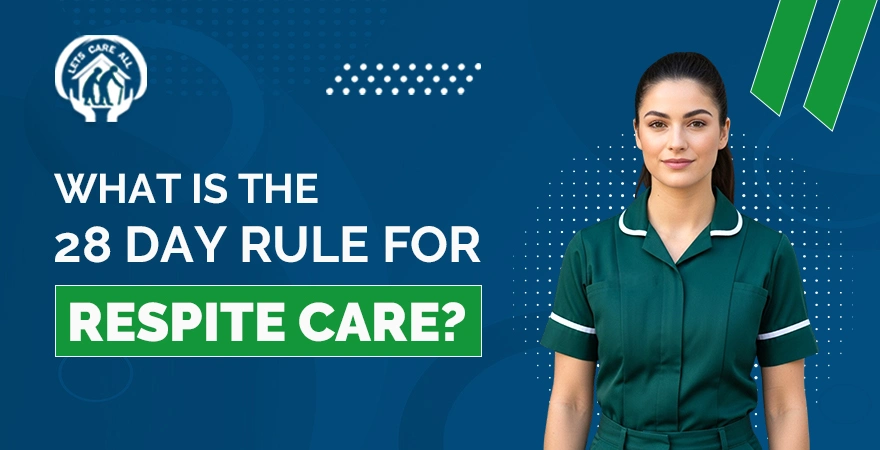- Southall, London
A call can make a DIFFERENCE
- Southall, London
A call can make a DIFFERENCE
A call can make a DIFFERENCE
Getting to Know Us!
Company Information and Customer Policies

Have you ever wondered how long your loved one can stay in respite care while you take a break? It’s a common question for many carers who need short-term support. Respite care gives your loved one safe, short-term care. This lets you rest and recharge. To guide how this support works, a rule known as the ’28-day rule’ is used. This rule shows how long your family member can stay in respite care. It helps you plan your breaks with clarity and simplicity. Many families hear about it, but they often remain uncertain about its true meaning. A proper understanding can make your care planning smoother and reduce stress. This article covers all you need to know about the 28-day rule for respite care.
Respite care is a short-term care service that provides relief to individuals who care for someone full-time. It allows carers to take a break while the person in need of support receives safe and professional care. In simple words, ‘what respite care means is a temporary arrangement that supports both the carer and the person who needs daily help.
Besides giving your loved one proper care, respite care can support you in several ways. For example, respite care can be helpful if you look after an older adult and need support with daily tasks. Parents who care for a child with disabilities can gain significant support. Respite care gives them the chance to rest. Moreover, it allows them to focus on their other children or manage personal tasks without any worry. Similarly, families often support a relative with long-term health issues. In such cases, short-term care can be beneficial.
Caring for someone full-time can be rewarding, but it also leaves you drained at times. That’s exactly why respite care is important because it gives you the chance to pause, rest, and regain your energy. Without these breaks, stress and tiredness can build up, making it harder to give your best every day. With respite care, you not only protect your own well-being but also ensure your loved one continues to receive the attention and support they need.
The 28-day rule in respite care sets a clear limit on the duration of stays. You or your loved one can stay in care for up to 28 days only. If the stay goes beyond this limit, it may be considered permanent care. When that happens, the rules for funding and allowances can change. This is why the 28-day rule is essential for both carers and families who rely on short breaks.
The 28-day rule comes from care policies and legal guidance in the UK. It exists to make sure respite care stays a short-term option and does not become permanent. Local councils and health services use this rule to decide how a period in care is classified. If the stay is short, it counts as a temporary break for you as a carer. However, if it lasts longer, authorities may treat it as permanent care. The rule also affects funding, benefits, and access to services. With it, you get a safe break, and your family avoids sudden changes in care arrangements.
You might be wondering how the 28-day rule actually works when you or your loved one stays in a care home. It can feel confusing at first, especially when benefits and support are involved. The good news is that this rule makes things clearer by showing you how long the stay can last and how your benefits are affected. When your loved one moves into a care home for a short stay, benefits like Disability Living Allowance (DLA), Personal Independence Payment (PIP), and Attendance Allowance continue for the first 28 days. After 28 days, these payments stop. This happens because the government provides these benefits to support you while you stay at home and need extra help.
If you return to a care home within 28 days of leaving, the days from both stays are added together. This rule is known as the linking rule. It ensures you cannot use multiple short stays to extend your benefits beyond the 28-day limit. Once your combined stays exceed 28 days, your benefit payments will stop.
The rule becomes clearer when you look at a simple case.If you stay in a care home for 15 days and then return home, your benefits will continue uninterrupted. But if you return to the care home within 10 days and stay for another 14 days, the system counts the total days together. This totals 29 days, which is longer than the 28-day limit. As a result, your benefits stop from that point onwards.
Another case is when you stay the full 28 days in one stretch. From the 29th day, your payments stop because the limit has been crossed. Authorities also refer to a third case as a long break or clock reset. If you leave the care home and stay at home for 29 days or more, the old count ends. When you return to the care home, a new clock starts. This means your benefits will continue for the first 28 days again.
The 28-day rule provides short-term support when a carer requires a break from their responsibilities. For those looking after an older family member, this rule is particularly significant. Many families ask, what is respite care for the elderly? It refers to short stays in a care home where the older person receives appropriate support while the carer takes time to recover. Under the 28-day rule for respite care, the stay is temporary and does not interfere with long-term care arrangements. Parents of children with disabilities may also benefit, as the rule allows them to rest, manage daily tasks, and spend time with other family members.
The 28-day rule exists to keep respite care clear and fair. It sets a limit so you know how long a short stay can last. This helps you plan your breaks without confusion. Many carers ask, when is respite care needed? You may need it when you feel tired, when your health is affected, or when personal tasks pile up. Sometimes it is also useful during holidays, after a hospital stay, or in an emergency. With this rule, your loved one gets safe short-term care, and you get the rest you need.
Arranging respite care is not the same in every situation. How quickly can respite care be arranged? The answer depends on the type of service you need, your health needs, and the availability in your local area. Emergency respite care can sometimes be arranged on the same day, giving you quick support in urgent situations. Planned respite care usually takes longer because it may involve assessments, paperwork, and booking a suitable place in a care home. This process can take a few days or, in some cases, even weeks. By discussing your needs in advance and making a plan, you can avoid last-minute stress. This way, both you and your loved one feel supported and confident that help will be available when needed.
Respite care offers vital support, yet it comes with certain limitations you should know about
Respite care and long-term care serve very different purposes. With respite care, you get short breaks that usually last up to 28 days. During this time, your loved one receives safe support, and you have the opportunity to rest and recharge. Long-term care, however, is a permanent arrangement for individuals who require daily supervision and ongoing assistance. The 28-day time limit clearly delineates where short-term support ends and long-term care begins. If your loved one stays in a care home beyond this limit, the authorities review the case and adjust the benefits accordingly.
The 28-day rule for respite care gives you the chance to step back from daily caregiving without worrying about your loved one’s safety or comfort. This clear timeframe helps you plan support with confidence while ensuring your family member continues to receive quality care. Caring every day can take a toll, and taking a short break is not only necessary but also vital for your own well-being. With respite care, your loved one stays in a safe, supportive environment while you regain the energy you need. Let’s Care All makes this transition stress-free and straightforward, offering compassionate, professional care that gives you peace of mind and your loved one the attention they deserve.
